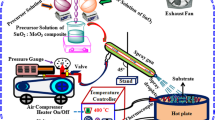Abstract
This work is concerned with the growth of TiO2 nanostructures as photovoltaic materials of dyesensitized solar cell (DSSC) via phase liquid deposition technique treated with CTAB surfactant. This work investigates the influence of organic dyes, N719, N3 and Z907 as photosensitizer on the photovoltaic parameters of TiO2 nanostructures dye-sensitized solar cells (DSSCs). It also highlights the effect of the concentration of the best dye, N719 on the performance of the cell. The platinum films as counter electrode of the DSSC were prepared by sputtering platinum pellet on ITO substrate. The redox couple of the electrolyte utilized in the DSSC was iodide/triiodide. The cell sensitized with N719 dye demonstrated the best performance compared with the cell sensitized with another two dyes, N3 and Z907. This is due to N719 dye possess the highest optical absorption in visible region. The cell sensitized with 0.8 mM N719 dye performs the highest short-circuit current density, J sc and power conversion efficiency, η since it posses the highest absorption in visible region. The DSSC utilizing 0.8 mM N719 dye demonstrated the highest J sc and η of 6.48 mA cm−2 and 1.69%, respectively.
Similar content being viewed by others
References
Grätzel, M., Nature, 2001, vol. 414, p. 338.
Grätzel, M., J. Photochem. Photobiol. Ser. C, 2003, vol. 4, p. 145.
O’Regan, B. and Grätzel, M., Nature, 1991, vol. 353, p. 737.
Yella, A., Lee, H.W., and Tsao, H.N., Science, 2011, vol. 334, p. 629.
Grätzel, M., J. Photochem. Photobiol. Ser. A, 2004, vol. 164, p. 3.
Chen, W., Qiu, Y., and Yan, K., J. Power Sources, 2011, vol. 196, p. 10806.
Umar, A.A. and Oyama, M., Crystal Growth Design, 2008, vol. 8, p. 1808.
Taer, E., Deraman, M., and Talib, I.A., Curr. Appl. Phys., 2010, vol. 10, p. 1071.
Angelis, F.D., Fantacci, S., and Selloni A., Nano. Lett., 2007, vol. 7, p. 3189.
Nazeeruddin, M.K., Baranoff, E., and Grätzel, M., Sol. Energy, 2011, vol. 85, p. 1172.
Lee, K.M., Hsu, C.Y., and Chiu, W.H., Sol. Ener. Mater. Sol. Cells, 2009, vol. 93, p. 2003.
Wang, P., Zakeeruddin, S.M., and Moser, J.E., Nat. Mater., 2003, vol. 2, p. 402.
Roza, L., Umar, A.A., and Rahman, M.Y.A., Adv. Mater. Res., 2012, vol. 364, p. 393.
Rika, T., Rahman, M.Y.A., and Salleh, M.M., J. Sol. State Electrochem., 2010, vol. 14, p. 2089.
Rahman, M.Y.A., Salleh, M.M., and Talib, I.A., Curr. Appl. Phys., 2007, vol. 7, p. 446.
Wu, S., Han, H., and Tai, Q., J. Power Sources, 2008, vol. 182, p. 119.
Yoon, J., Kang, D., and Won, J., J. Power Sources, 2012, vol. 201, p. 395.
Avellaneda, C.O., Gonçalves, A.D., and Benedetti, J.E., Electrochim. Acta, 2010, vol. 55, p. 1468.
Xu, H., Tao, X., and Wang, D.T., Electrochim. Acta, 2010, vol. 55, p. 2280.
Ohsaki, Y., Masaki, N., and Kitamura, T., Phys. Chem. Chem. Phys., 2005, vol. 7, p. 4157.
Baxter, J.B. and Aydil, E.S., Appl. Phys. Lett., 2005, vol. 86, p. 053114.
Krašovec, U.O., Berginc, M., and Hočevar, M., Sol. Ener. Mater. Sol. Cells, 2009, vol. 93, p. 379.
Kandavelu, V., Huang, H.S., and Jian, J.L., Sol. Energy, 2009, vol. 83, p. 574.
Perera, V.P.S., Pitigala, P.K.D.D.P., and Seneviratne, M.K.I., Sol. Ener. Mater. Sol. Cells, 2009, vol. 85, p. 91.
Author information
Authors and Affiliations
Corresponding authors
Additional information
Published in Russian in Elektrokhimiya, 2014, Vol. 50, No. 11, pp. 1192–1197.
The article is published in the original.
Rights and permissions
About this article
Cite this article
Rahman, M.Y.A., Umar, A.A., Roza, L. et al. Effect of organic dye on the performance of dye-sensitized solar cell utilizing TiO2 nanostructure films synthesized via CTAB-assisted liquid phase deposition technique. Russ J Electrochem 50, 1072–1076 (2014). https://doi.org/10.1134/S1023193514080114
Received:
Published:
Issue Date:
DOI: https://doi.org/10.1134/S1023193514080114




